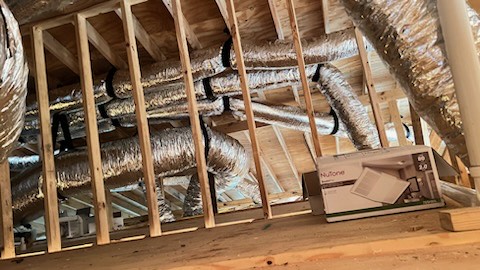Ventilation, Heating and air conditioning, abbreviated as HVAC is a system used in residential and commercial for heating and cooling. HVAC systems are ubiquitous. HVAC’s versatility in providing the best means to comfort has popularized their use from family homes to submarines. The HVAC system replaces stale indoor air with fresh outdoor air and keeps a place ventilated and healthy.
HVAC system have become a crucial part of our lives.Imagining life without them is difficult today. But their importance, only someknow the basics of HVAC.
How does HVAC work?
The HVAC system has three primary functions, which are interrelated and responsible for providing good indoor air quality and thermal comfort. The heating and air conditioning system is indispensable in our time. Though it is one of the most complicated systems at home, you cannot do without it even for a day.
There are different parts to your HVAC system – 9 to be exact – and we, in this blog, will familiarize you with all the nine parts. The nine parts are (1) Filter, (2) Exhaust, (3) Outlets, (4) ducts, (5) Coils, (6) Blower, (7) Compressor, (8) Electrical elements, (9) Outdoor unit.
Let us now discuss these nine different parts in detail:
1. Air Return:
This is the first and one of the most crucial parts of your HVAC systems. Air return marks the beginning of the ventilation cycle. The function of the air return is to suck in air from outside and make it pass through the filter before releasing it inside your home or office. It would be best if you kept the air return dust free. Dust and dirt can accumulate over time and compromise the efficiency and effectiveness of Air Return in your HVAC.
2. Filter:
A filter in HVAC comes after Air return. The filter filters the air and improves air quality. Filters need to be changed regularly for best results.
3. Exhaust:
The exhaust outlet plays a crucial role in your HVAC system. They expel the exhaust created by the heating system and maintain air quality.
4. Duct:
A duct is the channel through which heated or cooled air is passed. Ducts don’t need frequent attention. But you must clean the chimney in your HVAC system every two years for optimal performance.
5. Electrical elements:
Electrical elements are complicated, and all problems begin here. Check for dead batteries if your HVAC system’s electrical components are not working correctly. It is also better to take professional help changing the battery than a DIY approach.
6. Outdoor unit:
Outdoor unit has a fan that provides airflow to your home or office space. Ensure nothing gets sucked into the outdoor unit, as debris or plants can cause severe damage to it.
7. Compressor:
A compressor is a part of the outdoor unit of an HVAC system. It converts refrigerants from gas to liquid. The compressor is a crucial component of your HVAC system and can cause many failures in the HVAC system if proper care is not taken.
8. Coils:
Coils are another essential component of the outdoor unit in the HVAC system. With some help from the refrigerants, coils cool the air as it passes through. Coils need to be checked annually. If they stop functioning properly or freeze, check the level of refrigerants.
9. Blower:
The primary function of the blower is to provide warm air through the primary section of the unit. Ensure efficient flow of air to optimize the functioning of the blower.
How long does an HVAC system last?
Durability depends from brand to brand. But usually, HVAC systems last very long. If you take proper care of your HVAC system by cleaning them annually, it can last for a long time. You have to ensure all components we discussed above are functioning optimally and that there is no accumulation of dust and debris on any parts of your HVAC system.
Different types of HVAC system
There are broadly five categories of HVAC systems. We discuss all these five systems in detail below.
1 Split system:
This system is also called a forced-air system. A split system is named so because it has units outside the home and one unit inside. This setup can be of an air-conditioner and a furnace, a furnace and heat pump, etc. The location of your home and the surrounding environment will decide which system works best for you.
2 Hybrid heat pump:
Hybrid heat pump includes an electric heat pump in the central heating system. Electric heat pumps complement the work of a furnace. During winter or mild seasons, the heat pumps heat your home and maintain a comfortable temperature at your home and office.
3 Ductless mini-split:
A Ductless mini-split contains an outdoor unit with a compressor and a condenser. A ductless mini-split also has an indoor air handler on the top of the room where the cooled air blows. This system works best in small spaces. They can only be used for part of the house. The benefit of this type of HVAC system is that anyone can install them.
4 Ducted mini-split system:
A ducted mini-split is for a place large enough to house a lot of traditional ductwork. This system uses tubes in place of ducts to move air in and out of a room.
5 Packaged system:
In a packaged system, all the components are outside the home. This system is designed for small houses with no space for heating components. Packaged systems make less noise and their installation charges are affordable.
Conclusion:
HVAC systems have become a crucial part of our lives. Imagining life without them is difficult today. But despite their importance, only some know the basics of HVAC. To make the right choice while buying Ventilation, Heating and Air conditioning system, you must know all the relevant facts and their functioning. The right decision can be made only when you have the right facts.


